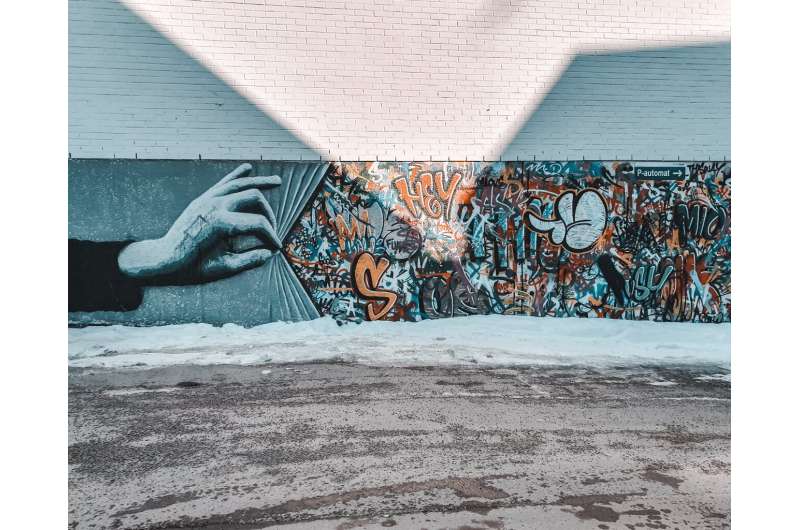This article has been reviewed according to Science X's editorial process and policies. Editors have highlighted the following attributes while ensuring the content's credibility:
fact-checked
trusted source
written by researcher(s)
proofread
Images shape cities, but who decides which ones survive? It's a matter of visual justice

In the early hours, poster installers head out with buckets of wheat paste and gig advertisements, refreshing the thousands of square meters of street poster sites in Melbourne. Graffiti writers and artists also take to the walls with their pieces. Municipal surface cleaners soon follow with chemicals and pressure washers.
Our city buildings are covered with posters, signs, art and graffiti. Their creators' tools are images: profitable, seductive, confronting, removed.
Yet we rarely think about their collective role in articulating social values. While their creators' values might differ, their ambition is the same: a higher stake in shaping the image and values of the city.
Our research draws together municipal agendas with a critical history of how public images are produced and regulated in cities. The aim is to develop ways to deal with images in more responsive and creative ways. How can we better manage them to support social justice, diversity and belonging in cities?
Images are instruments of urban governance
Managing urban images is a priority for municipal governments across the world. Melbourne, the source of the images in this article, is no exception.
Urban branding, graffiti removal, mural art and graphic heritage are just some of the ways in which the city is governed through images. They contribute to how we read urban environments and can create a strong sense of place, identity and character.
At the same time, individual actions in creating images form a collective visual discourse. Displaying political placards in street-facing windows, writing graffiti on public walls or painting over unwanted tagging are all visual contributions to the city's image and character.
While we may not agree on which of these approaches should take precedence, images play a significant role in how we all encounter, navigate and experience urban spaces. They form an urban aesthetic that is continuously calibrated by state and private actors.
We value some images above others
The more successful instances of urban visual infrastructure are often innocuous. As the saying goes, great design is invisible. But it can also be informal, unregulated or even illegal.
A visit to the recently opened City of Melbourne Art and Heritage Collection reveals how unplanned images such as stickers, stencils or protest signs deserve attention alongside their standardized counterparts such as traffic signs, wayfinding signs, and memorial plaques. Yet our understanding of their cultural value remains partial and biased.
For example, more than 100 public murals are listed in the Victorian Heritage Register. Also listed are a handful of building signs that many Melbournians will know: the Skipping Girl, Pelaco and Nylex signs in Richmond, and the Whelan the Wrecker sign in Brunswick.
However, graffiti is nowhere to be found in the upper echelons of our value scales for urban images. Neither are street posters, stickers or other mundane images that shape and enliven our public spaces.
Recent research on the governance of graffiti and street art, alongside our interviews with local authorities and graffiti removal companies, indicate the following:
- public image policies often value visual order above aesthetic and expressive diversity
- the protection of private property is prioritized over the imaginative use of public surfaces as a shared, common resource
- we enforce these values by privileging certain voices over others in the expression of public life and urban experience.
All public images are culturally significant
Could we apply heritage principles of cultural significance to the names and messages scribbled next to our local tram stop in the same way as we do to murals or ghost signs? And could we develop more nuanced value protocols for public images in the face of increased social division?
Images in public space reflect and represent divergent social values. As a result, they force us to confront our individual and societal biases.
Cities are never unanimous, harmonious congregations, and neither are their public images. They are also bastions of resistance, radical politics and competing claims to urban rights. Protest signs, graffiti tags and political posters and stickers are social infrastructure.
As urban dwellers, our right to the city includes the ability to edit our urban environments and contribute directly to urban visual culture. Healthy urban environments grow at the intersection of all these image types, in their places of tension and disagreement—what we refer to as "urban visual justice."
On your next journey through the city, stop to appreciate the variety of images it shows you. Which values do they capture and promote? What is visible and what is not? And where do you fit in?
A research and policy framework for urban visual justice can lead to greater belonging, representation and justice in urban experience. It improves visibility and voice for communities in public space. If we pay enough attention, images can teach us everything we need to know about cities.
Provided by The Conversation
This article is republished from The Conversation under a Creative Commons license. Read the original article.![]()




















